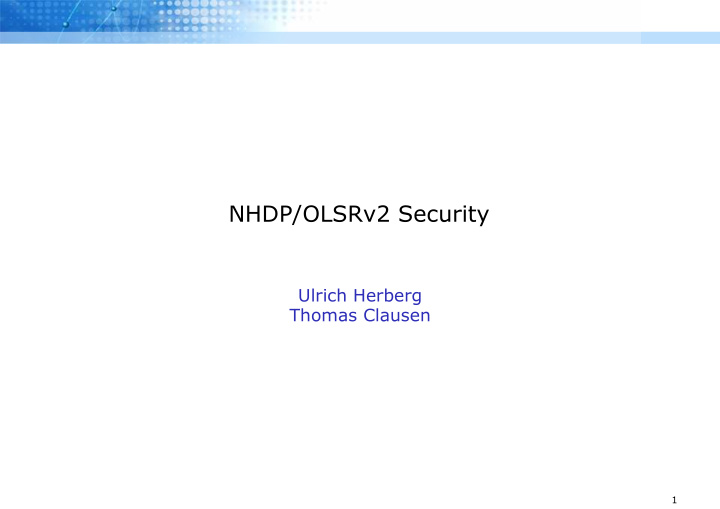



NHDP/OLSRv2 Security Ulrich Herberg Thomas Clausen 1
Reminder draft-herberg-manet-packetbb-sec Proposed I-D is a common extension to RFC5444, intended to be applicable where RFC5444 is applicable. Simple mechanism for carrying a signature, as address block, message, packet TLV Reminder draft-herberg-manet-nhdp-sec Add signature TLV to messages with value: <sign-tlv> := <hash-fkt><sign_algo><sign> Signing messages: sign = sign_algo(hash-fkt(message)) Validating messages: verified = verif(message, <sign-tlv>) 2
Updates from packetbb-sec-02 to -03 Editorial changes Introduced Address Block TLVs for signatures and timestamp fine-grained security (i.e. sign “both ends of a link”) 3
Fine-grained security in NHDP/OLSRv2 Problem when using signed control messages as in draft-herberg-manet-nhdp-sec and draft-herberg-manet-olsrv2-sec: Required trust in links advertised by a router Possible solution: sign each address in an address block 4
Fine-grained security in NHDP/OLSRv2 Additional security when chain of trust cannot be assumed Message size grows significantly (linearly with density) Will be included in next revision of nhdp-sec draft 5
Security Vulnerability Analysis of NHDP/OLSRv2 (complete analysis in http://hal.archives-ouvertes.fr/inria-00456376/en/ ) Analysis will be integrated into draft-herberg-manet-nhdp-sec-threats and draft-herberg-manet-olsrv2-sec-threats 6
Link State Vulnerability Taxonomy Proper functioning of OLSRv2 assumes that each router can acquire and maintain an accurate topology map, and that the network converges. OLSRv2 networks can be disturbed by breaking either of these assumptions: routers may be prevented from acquiring a topology map, or routers may acquire a wrong topology map, or routers may acquire inconsistent topology maps. 7
Topology Map Acquisition Flooding disruption by identity spoofing a can select b or d as MPR if it selects b , X can disrupt flooding by not forwarding traffic ( c is unreachable by flooded traffic) b can select a or c as MPR if it selects a , x (white) is unreachable by flooded traffic 8
Topology Map Acquisition Flooding disruption by link spoofing X spoofs links to c and w a will select X as MPR flooding is disrupted (routers “left” of b are unreachable by flooded traffic) 9
Topology Map Acquisition Radio Jamming interfaces on a “jammed” channel are unable to receive HELLOs or TCs depending on the L2, transmission of control traffic may still be possible some inherent protection of NHDP by ignoring unidirectional links 10
Topology Map Acquisition Hop Limit decreasing hop limit reduces scope of TC message 11
Topology Map Acquisition Hop Count When set to 255, TC messages will not be forwarded When value is reduced, validity time may be affected when using distance-dependent validity times (RFC5497) 12
Effective Topology Incorrect forwarding (data traffic) No influence on routing protocol, but discrepancy between effective and perceived topology Wormholes Traffic is recorded and tunneled through an “out-of-band” channel Harmfulness depends on characteristics of the wormhole, and how paths are calculated 13
Effective Topology Sequence number attack Denial-of-service attack using message sequence numbers or ANSN Message timing attacks Decreasing validity time Decreasing interval time when using link quality 14
Effective Topology Indirect jamming (neighborhood discovery) Switching between SYM and LOST status of an advertised link Leads to in-router resource exhaustion (MPR recalculation) Possibly triggers HELLOs/TCs 15
Effective Topology Indirect jamming (link state advertisement) Switching between MPR and LOST status Leads to in-router resource exhaustion (routing set recalculation of other routers) Possibly triggers TCs 16
Inconsistent Topology Inconsistent Topology Maps due to Neighborhood Discovery X does not participate in link state advertisement procedure Traffic transiting d will be forwarded to X rather than to the intended destination Traffic transiting c with b as destination, will be delivered to the intended b Traffic transiting c with a as destination may be delivered to the intended a via b or to the malicious router via d 17
Inconsistent Topology Inconsistent Topology Maps due to link state advertisement f selects X as MPR b and c will route traffic towards a to the intended destination e and f route traffic towards a to X 18
Inconsistent Topology Routing Loops g ignores TCs originating from itself Perceived Topology in g Perceived Topology in f 19
References U. Herberg, T. Clausen, “MANET Cryptographical Signature TLV Definition”, draft-herberg-manet-packetbb-sec-03 U. Herberg, T. Clausen, “Cryptographical Signatures in NHDP”, draft-herberg-manet-nhdp-sec-00 U. Herberg, T. Clausen, “Security Threats for NHDP”, draft-herberg-manet-nhdp-sec-threats-00 20
Recommend
More recommend